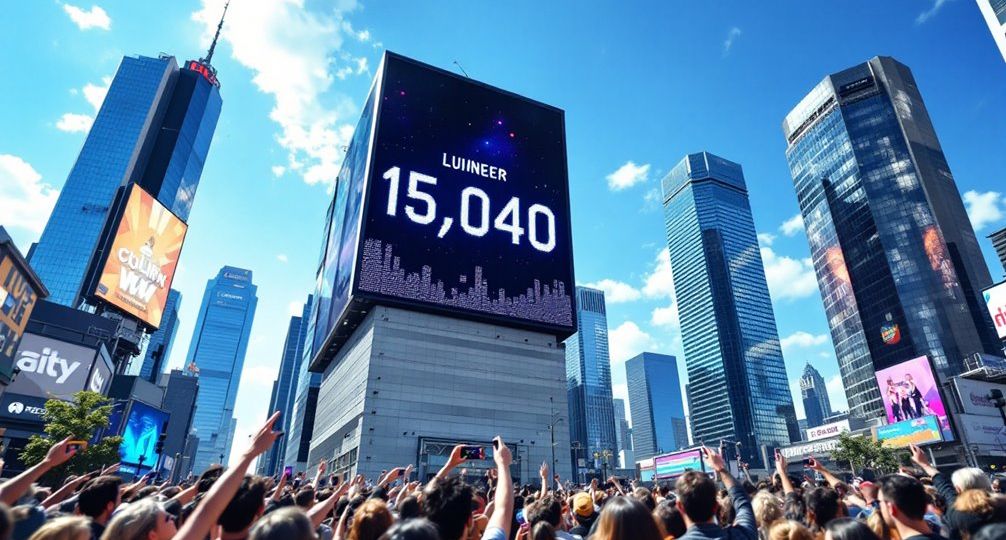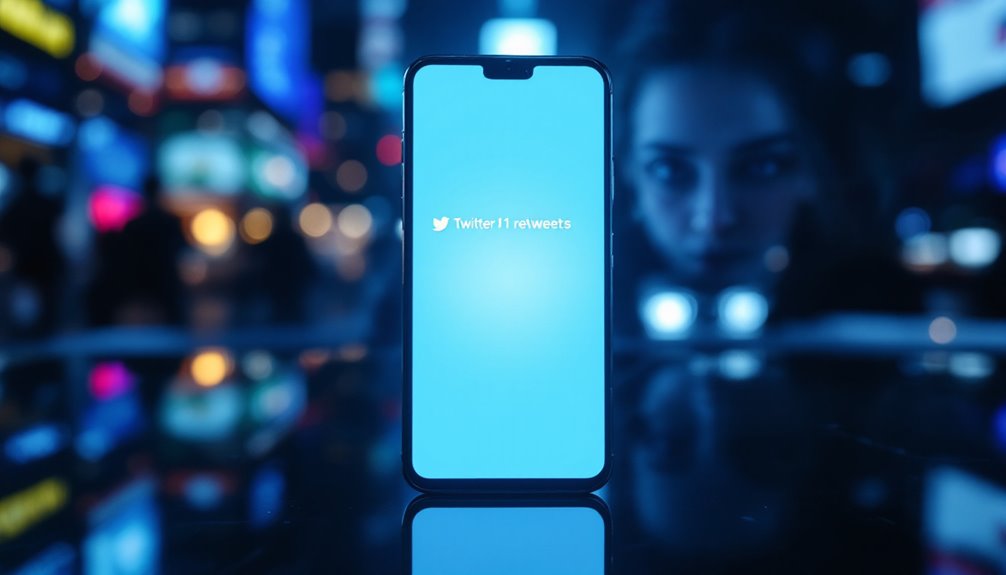
When you think about what makes a tweet go viral, it’s not just about hitting a specific number of retweets. The concept of virality is fluid, hinging on factors like your follower count and engagement levels. For smaller accounts, a few hundred retweets might signal a viral moment, while larger accounts need thousands. But there’s more to it than sheer numbers. What role do timing, content, or even trends play in this digital dance? Understanding these nuances could change how you perceive social media success. Are you ready to explore what truly defines a viral tweet in today’s ever-connected world?
Key Takeaways
- A retweet-to-follower ratio above 2.16 is a strong indicator of a viral tweet.
- Tweets that achieve 1000+ retweets often reach viral status, depending on the account size.
- High engagement rates, such as 2.4% from impressions, suggest virality.
- Viral detection models use prediction algorithms to quantify viral potential.
- Content relevance and emotional resonance significantly influence retweet counts.
Defining Viral Tweets

Understanding what makes a tweet go viral involves analyzing several key characteristics. Primarily, viral tweets often contain content that’s interesting, humorous, or relatable, tapping into a humor appeal or emotional resonance that captures wide attention. By addressing shared experiences, emotions, or societal challenges, these tweets evoke intense feelings, whether it’s joy, surprise, or outrage, making them more likely to be shared.
Engaging visuals further enhance this effect, as tweets with images are 34% more likely to be retweeted, underlining the significance of visual appeal in boosting virality.
To craft a tweet that stands out, you should focus on creating concise, impactful content, ideally around 120 characters. This brevity guarantees clarity and maximizes engagement. Effective content types include funny memes, inspiring quotes, and unique perspectives that challenge conventional ideas.
Timeliness is also vital; tweets that capitalize on current events or trending topics are more likely to engage a large audience quickly. By strategically leveraging trending hashtags and tapping into timely discussions, you can greatly enhance your tweet’s reach. Consistent activity, such as tweeting regularly, plays a crucial role in increasing visibility among followers, leading to higher engagement and the potential for virality.
Ultimately, viral tweets often succeed by aligning with users’ beliefs and achievements, encouraging them to share in pursuit of social approval.
Retweet Ratio Analysis
The Retweet Ratio Analysis serves as an important tool for gauging the reception of a tweet. By using the formula Comments / (Retweets + Likes), you can identify trends in how your content is being perceived. A high ratio often signals a negative reaction, while a lower ratio suggests positive engagement.
When it comes to retweet trend analysis, a ratio above 1 means more comments than endorsements – not ideal. If it climbs past 10, expect severely negative feedback, indicating a need for comment sentiment evaluation to understand the backlash. High comment ratios can overshadow positive engagement metrics, indicating public outrage or disagreement with content.
A balanced ratio of 0.5 points to equilibrium among comments, likes, and retweets, suggesting your content resonates well without sparking controversy. Understanding this balance is vital for innovative content creators aiming to optimize their social media strategies.
Remember, comments can be deceptive; they might seem supportive but often include debate or criticism. Thus, don’t ignore the context.
Incorporating URLs and hashtags boosts retweetability, while timing and user profile factors like account age and activity level can influence retweet rates. By mastering these elements, you can enhance your tweet’s reach and guarantee its success aligns with your goals for impactful online presence.
Content and Engagement

When dissecting what makes content and engagement flourish on social media, it’s crucial to focus on the elements that drive virality. Your content strategy should leverage humor, irony, and emotional resonance to capture attention. Tweets that evoke laughter or awe are more likely to be shared, generating significant engagement.
A data-driven approach reveals that:
- Emotional Evocation: Tweets that stir strong emotions—positive or negative—tend to be shared widely.
- Unique Perspectives: Content offering fresh insights stands out, capturing the interest of your audience.
- Relevance: Addressing current events or trending topics increases the chances of your content going viral.
- Social Approval: Users are motivated to share content that aligns with their beliefs, seeking validation and connection.
Understanding these dynamics enhances your content strategy, allowing you to design tweets that not only resonate emotionally but also drive engagement. By incorporating engagement techniques such as humor and calls-to-action, tweets can further increase their likelihood of being shared and discussed.
Timing and Trends
Timing’s essential role in achieving tweet virality can’t be overstated. Retweet timing is important, as most cascades gain momentum right after the first retweet. The initial wave of retweets, even if shallow, sets the stage for how far and fast your tweet will spread.
An intriguing insight: the median first-level infection probability is merely 0.00046, suggesting that early impressions are significant. By posting your tweet early on emerging trending topics, you increase its chance to be part of the rapid spread that characterizes viral content. Tweets that are longer (240-259 characters) can yield higher engagement rates, increasing the potential for a tweet to become viral.
The speed of retweeting helps identify trending topics, with tweets traveling an average of 950 kilometers. This fast diffusion means your content can gain traction well beyond your immediate network.
While specific peak retweet hours aren’t pinpointed, the first few hours post-tweet are important. Engaging audiences early can forecast the potential for later virality.
Regarding topic trends, tweets related to broad subjects often achieve higher structural virality, while niche topics remain limited. The longevity of viral tweets varies, often dictated by the continuous engagement they receive.
Staying attuned to these dynamics can help you strategically position your tweets for maximum impact.
User Influence Factors

To understand how tweets go viral, consider the direct impact of followers and the dynamics of network diffusion. It’s important to note that the credibility of the user retweeting can further amplify a tweet’s reach, as users are more likely to engage with content shared by someone they perceive as an expert or trustworthy in a specific domain. Even a single retweet from a user with a substantial following can drastically increase a tweet’s reach, potentially reaching thousands of additional users. Furthermore, the speed and pattern of retweets within a network play a critical role, as rapid diffusion often correlates with higher levels of engagement and virality.
Followers Impact on Virality
In terms of understanding virality on social media platforms, the number of followers plays a significant role. A higher follower count increases your tweet’s potential to go viral, but that’s just the beginning.
The concept of follower engagement is essential. Highly engaged followers are more likely to retweet your content, amplifying your reach. Verified users, often seen as influencers, wield significant impact due to their credibility and established networks.
Here’s how followers affect virality:
- Follower Count: More followers mean more eyes on your tweets, boosting initial visibility and retweet potential.
- Verified Status: Being verified often correlates with higher retweet rates, thanks to enhanced trust and credibility.
- Follower Engagement: Engaged followers tend to share content more, directly increasing the chances of a tweet going viral.
- Influencer Effect: Influencers with at least 12,000 followers have a built-in audience ready to amplify their messages.
The structure of your follower network also matters. An interconnected network can further propel your tweet’s reach.
Understanding these dynamics can empower you to strategically leverage your followers for greater influencer impact and viral success.
Network Diffusion Dynamics
Understanding network diffusion dynamics involves analyzing how information spreads across social media platforms. Information diffusion models, particularly those grounded in information thresholds, reveal that viral spread results from collective threshold behaviors.
However, these models often overlook individuals’ optimization challenges in sharing information. By employing a microfounded general threshold model, you can better grasp the complexities of individual behaviors when exposed to multiple information sources. This approach sheds light on how diffusion processes can unexpectedly break symmetry or lead to social polarization, making the virality of competing information fundamentally indeterminate. In fact, the unpredictable nature of these dynamics can result in varied degrees of polarization, influenced by both chance and individual choices.
To effectively leverage network diffusion dynamics, consider factors influencing information spread: credibility, bandwidth, relevance, timing, and alignment. An influencer’s domain expertise and their ability to transmit knowledge through social media are vital.
The timing of information delivery and how well it aligns with audience needs also play pivotal roles. On platforms like Twitter, where the follower-following topology doesn’t adhere to a power-law distribution, short effective diameters enable rapid information diffusion, reaching an average of 1,000 users quickly.
Measuring Retweet Performance
When you’re evaluating retweet performance, consider using retweet ratio analysis, which compares retweets to the author’s follower count, providing a more nuanced view of virality. By examining engagement rate metrics, you can gauge how effectively a tweet captures audience interest relative to the author’s typical engagement levels. These methods not only highlight outliers in engagement but also adjust for the influence of follower count, offering a balanced measure of tweet performance. Adjusting the positive Tweet threshold in a social listening tool can impact the volume of Retweeted Tweets, allowing for a customized approach to match brand objectives.
Retweet Ratio Analysis
Analyzing the retweet ratio offers a strategic lens for measuring tweet performance, particularly in evaluating virality. By evaluating the retweets-to-followers ratio, you can gauge how a tweet resonates beyond sheer numbers and explore its true reach. Retweet thresholds become more meaningful when normalized by follower count, offering a nuanced view compared to raw retweet counts. Here’s how you can harness this approach:
- Retweets to Followers Ratio: Calculate the ratio of retweets to your followers. A viral tweet typically exceeds a threshold, such as 2.16, indicating widespread engagement relative to your audience size.
- Normalization by Followers: This aids in comparing tweets across varying user bases, providing a level playing field for users with different follower counts. This approach is useful for Premium users who can access detailed metrics, such as engagement rates, via X Analytics, which helps in tracking audience interaction.
- Viral Tweet Classification: Automatically classify tweets as viral when their ratio surpasses the set threshold, offering a more accurate representation of virality.
- Threshold Adjustment: Fine-tune the threshold to balance between minimizing false positives and maximizing true viral identifications.
Engagement Rate Metrics
Engagement rate metrics provide an essential lens through which you can measure the performance of retweets on Twitter. By analyzing these metrics, you gain insights into how effectively your engagement strategies resonate with your audience demographics. On Twitter, key interactions include retweets, replies, likes, and tweet expansions, all of which contribute to the overall engagement rate. This rate is calculated using multiple methods: by reach, post, or impressions. For instance, the engagement rate by reach involves dividing total engagements by reach and multiplying by 100. Engagement benchmarks vary by industry and platform, which means that understanding engagement benchmarks for your specific field can significantly enhance your content strategy. To optimize your strategies, focus on Twitter-specific metrics like clicks, follows, and hashtag performance. High engagement rates, such as the benchmark of 2.4% from total impressions, indicate strong audience interest and can enhance your content’s visibility in social media algorithms. Success isn’t just in retweets but also in increased website visits from Twitter. Comparing your public engagement rate with competitors allows you to refine your approach. Analyzing historical data helps set realistic benchmarks and adapt to your audience’s evolving preferences. Embrace these metrics to innovate your Twitter strategy, ensuring your tweets don’t just reach your followers, but actively engage them.
Viral Detection Models

Virality is a multifaceted phenomenon that viral detection models endeavor to quantify with precision. You can gain insights using viral prediction algorithms, which aim to refine tweet virality assessment by analyzing patterns and behaviors. Researchers have introduced a new metric that focuses on the retweet-to-follower ratio, providing a more accurate approach to detecting viral tweets. For smaller accounts, threshold-based metrics leverage the ratio of retweets to followers, with a threshold of 2.16, to identify viral tweets without relying on engagement metrics like likes. This method, rooted in publicly available Twitter data, reduces false positives.
Transformers-based models, like BERTweet, excel with an F1 score of 0.79, relying solely on content features. Their openness, with data on GitHub, supports innovation and community-driven improvements.
Consider the following:
- Threshold-based Metric: Optimized for smaller accounts, reducing false positives.
- Transformers-Based Models: BERTweet stands out, peaking at an F1 score of 0.79.
- Proactive Detection: Focuses on identifying potentially viral tweets to manage misinformation early.
- Evaluation Metrics: Utilizes accuracy, precision, recall, and F1 scores, alongside ROC curves for robust model evaluation.
Statistical Insights on Virality
Understanding what makes a tweet go viral involves an in-depth exploration into statistical thresholds that provide clarity on retweet dynamics. When you examine the absolute retweet threshold, a figure of 50 emerges as essential. It’s notable that only 4% of tweets surpass this number, hinting at a viral tweet potential. A z-score above eight further refines this classification. This threshold, especially useful for accounts with varying follower counts, minimizes false positives by isolating tweets with genuine viral potential.
Consider the retweet to follower ratio, where exceeding 2.16 signifies virality. This method, advantageous for smaller accounts, normalizes retweets based on follower count, ensuring a fair assessment. Such statistical correlation is derived from Twitter’s “Viral Tweets” experiments, sharpening the precision of viral tweet identification. Early detection of viral tweets is essential for maintaining discourse integrity, as viral tweets can reach vast audiences rapidly.
Relative retweet metrics rely on comparing retweets to a user’s median or average performance, reducing false positives by contextualizing within typical engagement levels.
Beyond these metrics, contextual and content-based factors—like URLs and hashtags—hold strong statistical correlation with a tweet’s retweetability. Combined, these insights empower you to recognize and predict viral tweets with data-driven accuracy.
















